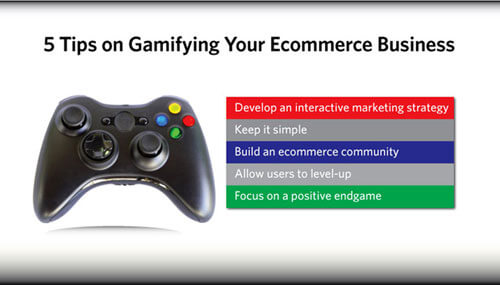Entertainment
How to Gamify Your E-commerce Business and Engage Customers
By Angela Bao

You need to keep shoppers playing the game if you want to win in e-commerce.
Heather Zadra furrows her brow when she notices that, in the remaining few seconds of the auction, someone else had upped their offer on a pair of handmade leather cowboy boots she was eyeing. Quality cowboy boots can easily cost hundreds of dollars, but these are hovering around $60. Quickly, she increases her bid amount right before the timer hits zero; a few seconds later, she receives an email notifying her that she has won.
Despite her successful bid, Zadra, a regular eBay shopper and seller, isn’t about to call it quits—in fact, she only feels more motivation to win her next eBay bargain.
“I get a rush of adrenaline in those last 60 seconds,” Zadra says. “After the first win, it’s like I see myself as better than the competition, which gives me more confidence to jump into more auctions. It just goes to show how addictive human nature can be.”
Why gamification works for e-commerce
Why are sites like eBay so successful and addictive to users like Zadra? Because of a tactic called gamification.
Most people are familiar with the concept of games, perhaps have even played a few, whether it’s classics like chess, or video games like World of Warcraft. Games, especially in the digital sphere, are designed to be addictive, incite strong emotions in the player, and keep users coming back day after day to discover new things—all of which e-commerce businesses desire from their customers.
E-commerce gamification taps into people’s core desires in order to get them to engage with a site—and hopefully make a purchase, as well. Yu-kai Chou, creator of the Octalysis Framework for Gamification Design, boils it down to what he calls the “8 Core Drives” of human motivation. The drives range from “epic meaning and calling” (making consumers feel inspired and as if they are a part of something bigger than themselves), to “loss and avoidance” (playing up consumers’ fears of losing what they see as rightfully theirs). In Zadra’s instance, eBay was playing up the competition between multiple consumers, as well as tapping into Zadra’s fear of losing a bargain. “All of what we do is based on one or more of these eight core drives,” Chou says, “which means, if none of those drives are there, then there’s zero motivation”—and no one will be using your site.
Gamifying e-commerce is a multi-step process that requires action on all levels. E-commerce businesses need to engage their customer base, from start to finish, says Chou. Done properly, gamification could increase your business’ online traffic and boost customer loyalty.

How to gamify your online business
At Tophatter, a San Francisco, Calif.-based e-commerce company, gamification is built into its platform. Like eBay, Tophatter is an online auction site that capitalizes on its users’ competitiveness, but instead of allowing several days for customers to bid, Tophatter auctions last only 90 seconds; customers have to act fast if they want to snag an item. Combined with the low prices—most products are only a few dollars—customers feel “a lot of urgency around having to purchase it, similar to a flash-sale concept,” according to Megan Wang, Tophatter’s head of China supply.
However, there is a multitude of ways to gamify e-commerce beyond creating a game-like platform. Below are some tips and methods for how to get users to engage on every level and reach that end goal: making sales.
- Develop an interactive marketing strategy
Having an interactive, gamified marketing strategy can get customers and potential customers to engage with your company outside of your site or app. Strategies could be anything from partnering with an actual gaming company like Best Buy did with Zynga, which engages users beyond your company’s realm of influence, or by creating a digital scavenger hunt for users to unlock rewards. “Collection sets are pretty useful,” suggests Chou. “Let’s say, when you go on your site, there’s a scavenger hunt with little collectible objects. If you go around and buy things, you’ll randomly unlock these items, and when you get all seven or however many, something cool then happens.” These sorts of methods tap into people’s curiosity, as well as their desire to “own” the entire set.
- Keep it simple
As an e-commerce businesses, you want customers to feel smart, and an easy way to do that is to make sure your site’s user interface is relatively simple.
Tophatter underwent a redesign that drastically streamlined its look. Originally, the site was designed to look like a virtual auction house, with a computer-animated auctioneer at the front and avatars that hopped up and down as people bid on items. However, Tophatter decided to cut back on the graphics and focus more on providing customers what they wanted; the simplified look helped improve both sales and user engagement. “It was really more about how we could reduce information overload,” says Wang. “When you go online, it’s just a lot of information—how do you get through it all?”
Keeping it simple also allows you to encourage the customer to do what you want them to. “The desired action always needs to be very clear,” emphasizes Chou. “If you look at things like Amazon, the interface has something I call a desert oasis design: there’s a lot of stuff around, but the desired action is always clear and colorful in front of people’s eyes.”
- Build an e-commerce community
Most games require at least two people to play, so it’s important to translate that social aspect into e-commerce, too. At Tophatter, users can see, in real-time, the names of all the people who are bidding on items. “When you feel like you are surrounded by friends and people, even people from different countries, and feel that community experience—that can really captivate consumers,” says Wang.
A simple way to develop an e-commerce community is to let users leave product reviews; in fact, 69 percent of online shoppers say they want more reviews on e-commerce sites. “People like reviews,” adds Chou, “because a lot of behavioral science says we don’t trust the professional critics as much as the average Joes.”
But how do you incentivize people to leave reviews in the first place? “You have to ask yourself: what is the emotional reward [for the reviewer]?” says Chou. “Usually, a great way to reward them is those little thumbs-up or thumbs-down icons. They left a review, and three people say ‘I liked your review’—now they feel happy and are more likely to review more.” Allowing users to interact with each other strengthens your e-commerce community and encourages customers to keep coming back.
- Allow users to “level-up”
The concept of “leveling up” applies both to buyers and sellers, which is particularly useful if you have a marketplace type of e-commerce site, like eBay or Etsy.
On the seller side of things, Chou says it’s important to encourage them to not only continue selling, but also to improve their service. In reference to eBay, Chou says, “We see [sellers] go from a yellow-star seller, to a purple star, to a power-rated seller. As they progress, they unlock certain benefits, like more free shipping.” Essentially, the better the service is, the more likely customers are to leave good reviews and make more purchases.
Buyers should also receive similar incentives. “Every time a buyer comes back to the site or leaves a review, they can get some points, and as time goes by, they start accumulating more points and status,” says Chou. Eventually, those points can also be redeemed for physical rewards, à la Sephora’s Beauty Insider rewards program.
- Focus on a positive endgame
While things like scarcity and flash sales tend to drive short-term sales, these tactics tend to enforce negative emotions in users that are hurtful to long-term customer retention, says Chou. “If people can find a way out, they will,” he cautions. “A very important thing about games is that there’s absolutely no reason to be on it if it’s not fun.” Hence, why Chou suggests e-commerce businesses improve their endgames, i.e. what keeps people coming back to sites.
To create a strong endgame, Chou advises people to focus on what he calls the “White Hat” core drives: empowerment of creativity and feedback (such as creating a competition that encourages creativity and thought), social influence (users writing reviews), and epic meaning and calling (developing a “bigger picture” company brand or culture). These are the drives that inspire positive emotions in customers that will make them want to come back.
The future of e-commerce
Many e-commerce sites have already found success with gamification, but that doesn’t mean it’s the end of the road. Tophatter wants to push that gamified experience further by personalizing content to each unique user—that means placing a big emphasis on cross-border e-commerce. “The unique aspect of our marketplace is that we’re serving up the most relevant products by using a lot of data and machine learning,” says Wang. “Our goal is to unlock the world’s supply, which is one of the reasons why we’re here in China, to provide more variety and options for our customers. By unlocking that supply, then it’s really about our role in identifying the most relevant products for consumers.”
Chou certainly seems to agree with Tophatter’s goals. “The future of e-commerce is combining artificial intelligence and big data to customize the gamification experience,” he says. “The companies who do that will be clear winners.”
Sign up for the Reach Further Newsletter
We’ll keep you in the know about the latest US-Asia business news and trends.
Suscríbase al boletín Reach Further
Lo mantendremos informado sobre las últimas noticias y tendencias comerciales entre Estados Unidos y China.

